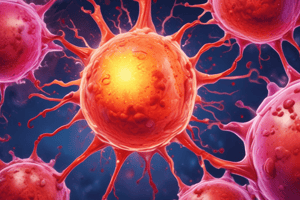Podcast
Questions and Answers
What primarily characterizes granulomatous inflammation?
What primarily characterizes granulomatous inflammation?
- Granuloma formation (correct)
- Any form of tissue necrosis
- Diffuse accumulation of lymphocytes
- Presence of only eosinophils
Which cells are primarily involved in chronic inflammation?
Which cells are primarily involved in chronic inflammation?
- Mesothelial cells
- Fibroblasts
- Macrophages and lymphocytes (correct)
- Neutrophils
The accumulation of modified macrophages in a granuloma are called what?
The accumulation of modified macrophages in a granuloma are called what?
- Giant cells
- Neutrophils
- Basophils
- Epithelioid cells (correct)
Which of the following describes non-specific chronic inflammation?
Which of the following describes non-specific chronic inflammation?
What is the function of giant cells in granulomatous inflammation?
What is the function of giant cells in granulomatous inflammation?
Which condition is an example of non-specific chronic inflammation?
Which condition is an example of non-specific chronic inflammation?
What is a common cellular feature of giant cells?
What is a common cellular feature of giant cells?
Tuberculosis is characterized by which histological feature?
Tuberculosis is characterized by which histological feature?
Flashcards are hidden until you start studying
Study Notes
Overview of Chronic Inflammation
- Involves a delayed response of tissue or organs to injury, persisting for weeks or months.
- Characterized by active inflammation, tissue destruction, and healing attempts occurring simultaneously.
Key Cells Involved in Chronic Inflammation
- Monocytes: Precursor to macrophages; migrate to sites of inflammation.
- Macrophages: Key players in chronic inflammation; engulf pathogens and debris.
- Lymphocytes: Includes T-cells and B-cells, involved in immune response.
- Plasma Cells: Produce antibodies; derived from B-lymphocytes.
- Eosinophils: Functions primarily in allergic responses and parasitic infections.
Morphologic Patterns of Chronic Inflammation
-
Non-Specific Chronic Inflammation:
- Diffuse accumulation of macrophages and lymphocytes at the inflammation site.
- Example: Chronic pancreatitis.
-
Granulomatous Inflammation:
- Characterized by the formation of granulomas, which are small nodular collections of modified macrophages.
Granuloma Formation
-
Granuloma:
- Composed of modified macrophages known as epithelioid cells, which have a squamous cell-like appearance.
- Surrounded by a rim of lymphocytes, plasma cells, eosinophils, and giant cells.
-
Giant Cells:
- Formed by the fusion of multiple macrophages, displaying large cells with a cytoplasm resembling epithelial cells and containing multiple nuclei.
Example of Granulomatous Inflammation
- Tuberculosis:
- Exhibits follicular clusters of epithelioid histiocytes and multinucleated giant cells.
- The outer region of follicles contains small lymphocytes and plasma cells, contributing to the immune response.
Studying That Suits You
Use AI to generate personalized quizzes and flashcards to suit your learning preferences.




